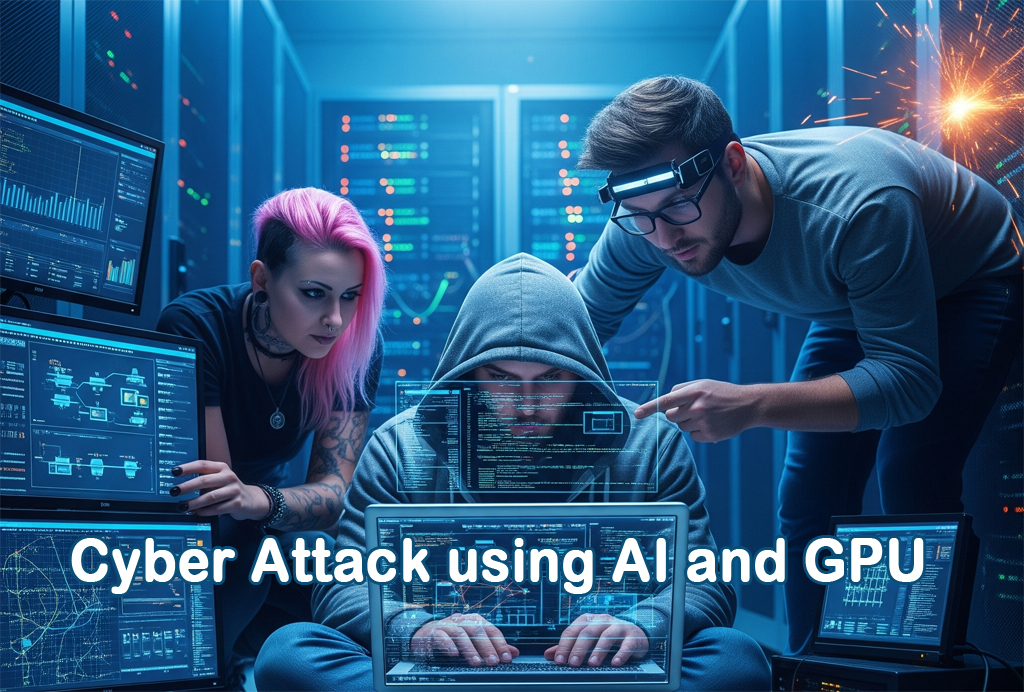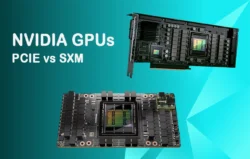Artificial Intelligence (AI) has transformed industries by leveraging the immense computational power of Graphics Processing Units (GPUs). Originally designed for rendering graphics, GPUs excel at parallel processing, making them ideal for accelerating AI tasks like machine learning and data analysis. However, this same technology has a darker side: cybercriminals are harnessing AI and GPU power to launch faster, stealthier, and more sophisticated automated cyberattacks against servers. From vulnerability scanning to malware deployment, GPUs enable attackers to outpace traditional cybersecurity defenses.
This article explores how GPUs fuel AI-driven cyberattacks, provides detailed case studies like GPUHammer and AI-enhanced phishing, examines the technical mechanisms behind these threats, and outlines strategies for organizations to stay ahead of this escalating challenge.
Table of Contents
The Power of GPUs in AI-Driven Cyberattacks
GPUs, such as NVIDIA’s A6000 or H100, are designed to handle thousands of tasks simultaneously, offering up to 600X faster processing than traditional CPUs for certain workloads. This parallel processing capability makes them indispensable for AI applications, but it also empowers cybercriminals. Below are the key ways GPUs are supercharging AI-driven cyberattacks:
- Rapid Vulnerability Scanning: AI algorithms, when paired with GPUs, can scan servers and networks at unprecedented speeds. By analyzing vast datasets—such as server configurations, open ports, or codebases—AI can identify vulnerabilities in minutes, a task that would take human hackers hours or days. GPUs accelerate this process by processing multiple scans concurrently, enabling attackers to target thousands of servers simultaneously. For example, tools leveraging GPU power can analyze network traffic or codebases to pinpoint exploitable weaknesses with alarming efficiency.
- Automated Payload Generation: Crafting malicious payloads, such as exploits for zero-day vulnerabilities, requires significant computational resources. GPUs enable AI to generate and test thousands of payload variations in real time, optimizing them to evade antivirus software or exploit specific server weaknesses. Recent SharePoint remote code execution (RCE) attacks (CVE-2025-53770), reported in July 2025, demonstrated how AI, likely accelerated by GPUs, was used to auto-generate payloads targeting over 85 government and energy sector servers, extracting keys from __VIEWSTATE with unprecedented speed.
- Adaptive Malware Deployment: AI-driven malware, powered by GPUs, can adapt to security countermeasures in real time. For instance, the ArmouryLoader malware, discovered in July 2025, leverages GPU-based OpenCL decryption to bypass endpoint detection and response (EDR) systems. By using GPUs to decrypt and execute payloads stealthily, ArmouryLoader exploits vulnerabilities in gaming software like ASUS tools to target enterprise systems. Similarly, the LAMEHUG malware blends AI and cyber-espionage tactics, likely relying on GPU acceleration to process complex tasks like evading detection or analyzing network traffic on the fly.
- Enhanced DDoS Attacks: Distributed Denial of Service (DDoS) attacks have become more potent with AI and GPUs. AI can orchestrate botnets dynamically, adjusting attack patterns to overwhelm servers while evading mitigation systems. GPUs enhance this by processing large-scale traffic data in real time, allowing attackers to optimize botnet behavior. For example, a GPU-powered AI could analyze a target server’s response to flood attacks and adapt strategies to exploit weaknesses, making traditional DDoS defenses less effective.
- Accelerated Password Cracking: Password cracking is computationally intensive, but GPUs make it alarmingly efficient. AI models, trained on user behavior and common password patterns, can prioritize likely combinations, while GPUs handle the brute-force calculations. Tools like hashcat, optimized for GPU use, can test billions of password combinations per second, enabling attackers to crack complex passwords in hours instead of weeks. This amplifies the risk of unauthorized access to servers, especially those with weak or reused credentials.
- Side-Channel Attacks: GPUs are vulnerable to side-channel attacks, where attackers exploit the GPU’s behavior to extract sensitive information. For instance, researchers have demonstrated attacks that can identify user browsing websites or track keystroke timing by analyzing GPU timing or power consumption patterns. These attacks are particularly dangerous in shared GPU environments, such as cloud platforms, where multiple users or applications run simultaneously.
- Malware Hiding in GPU Memory: GPUs can serve as a safe haven for malware, as their memory is often overlooked by traditional security tools focused on CPU activities. In 2021, a cybercriminal sold a method to hide malware in AMD and NVIDIA GPUs, demonstrating how attackers can store and execute malicious code stealthily. This technique allows malware to operate undetected, posing a significant threat to server security.
Case Studies: AI and GPU-Powered Attacks in Action
GPUHammer: Exploiting GPU Memory Vulnerabilities
In July 2025, researchers from the University of Toronto unveiled GPUHammer, the first successful Rowhammer attack targeting NVIDIA GPUs, specifically the A6000 model with GDDR6 memory. This exploit demonstrates how GPUs, critical for AI and high-performance computing, are susceptible to hardware-level attacks that can corrupt data and compromise system integrity.
- How GPUHammer Works: GPUHammer leverages the Rowhammer vulnerability, where repeatedly accessing a specific row in DRAM causes bit flips in adjacent rows due to electrical interference. Unlike traditional Rowhammer attacks on CPU memory, GPUHammer targets the GDDR6 memory in NVIDIA’s A6000 GPU. The researchers, led by Chris S. Lin, Joyce Qu, and Gururaj Saileshwar, overcame challenges such as proprietary memory mappings, high memory latency, and faster refresh rates by reverse-engineering GDDR DRAM row mappings and using GPU-specific memory access optimizations. They induced eight distinct bit flips across four DRAM banks using user-level CUDA code, bypassing in-DRAM defenses like Target Row Refresh (TRR).
- Impact on AI Models: The most alarming aspect of GPUHammer is its ability to degrade the accuracy of AI models. In a proof-of-concept, a single bit flip reduced the accuracy of an ImageNet deep neural network (DNN) model from 80% to 0.1%. This capability to silently corrupt AI models poses a significant threat to the integrity of AI-driven systems, particularly in shared or cloud-based environments where multiple tenants share GPU resources. Such attacks could lead to data poisoning, model parameter corruption, or privilege escalation.
- Mitigation and Defense: NVIDIA has recommended enabling System-Level Error-Correcting Code (SYS-ECC) to mitigate GPUHammer, as it can detect and correct single-bit errors. However, enabling SYS-ECC introduces a performance reduction of up to 10% for machine learning inference workloads and reduces available memory. Additionally, ensuring GPUs are used in single-tenant environments or with proper isolation between tenants can reduce the risk of such attacks. NVIDIA noted that simultaneous access to the GPU is required for a successful Rowhammer attack, making multi-tenant cloud environments particularly vulnerable.
- Broader Implications: GPUHammer underscores the need for continuous research and development in hardware security, especially as GPUs become integral to AI and other compute-intensive applications. It highlights the importance of enabling security features like ECC, even at the cost of performance, to protect against sophisticated hardware exploits. The attack also raises concerns about the security of cloud-based GPU infrastructure, where shared resources increase the risk of cross-tenant attacks.
In July 2025, hackers exploited a SharePoint remote code execution (RCE) vulnerability (CVE-2025-53770), combined with CVE-2025-49704 and CVE-2025-49706, to target over 85 government and energy sector servers. AI was used to auto-generate payloads and extract keys from __VIEWSTATE, demonstrating the power of AI-driven automation in cyberattacks. While specific details on GPU involvement are not confirmed, the computational intensity of generating tailored payloads at scale suggests GPU acceleration was likely used. This attack highlights how AI, powered by GPUs, can rapidly exploit server vulnerabilities, enabling attackers to compromise critical infrastructure with minimal human intervention.
ArmouryLoader and LAMEHUG: Malware Evolution
The ArmouryLoader malware, detected in July 2025, uses GPU-based OpenCL decryption to evade EDR systems, targeting vulnerabilities in ASUS gaming software. By leveraging GPU power, ArmouryLoader decrypts and executes payloads stealthily, showcasing how attackers exploit GPU capabilities to enhance malware stealth. Similarly, the LAMEHUG malware employs AI for cyber-espionage, likely using GPU acceleration to process complex tasks like real-time data analysis or evasion of security systems. These cases illustrate how GPUs enable malware to operate at speeds and scales that challenge traditional cybersecurity tools.
AI-Enhanced Phishing Attacks
Phishing attacks have evolved significantly with AI, becoming more sophisticated and harder to detect. AI allows attackers to craft highly personalized and convincing phishing emails by analyzing vast amounts of data about their targets, such as social media profiles, public records, and online behavior. This enables attackers to tailor messages to seem legitimate and trustworthy, increasing their success rate.
- Role of GPUs in AI-Enhanced Phishing: While direct evidence of GPU use in phishing attacks is limited, the AI models powering these attacks, such as large language models (LLMs), require substantial computational resources. LLMs, used for generating phishing content, are typically trained and run on GPUs due to their ability to handle parallel processing tasks efficiently. For example, NVIDIA’s Morpheus platform, which uses GPUs for spear phishing detection, suggests that similar GPU-accelerated AI models could be used by attackers to generate phishing emails at scale. The computational power of GPUs enables rapid analysis of target data and generation of convincing content, streamlining the creation of phishing campaigns.
- Impact and Examples: Research indicates that AI-generated phishing emails achieve success rates comparable to those crafted by expert human attackers. A 2024 study by the Institute of Electrical and Electronics Engineers (IEEE) found that 60% of participants fell victim to AI-automated phishing, highlighting its effectiveness. AI can generate content free of typical errors like poor grammar or spelling, making phishing emails harder to spot. Additionally, AI can create deepfake videos or audio mimicking trusted individuals, further enhancing phishing credibility. For instance, in 2023, a Hong Kong finance worker was tricked into wiring $25 million after a faked Zoom call with a deepfake CFO, likely created using GPU-accelerated AI models.
- Defensive Measures: To combat AI-enhanced phishing, organizations must adopt AI-driven security solutions that analyze email content, user behavior, and other indicators to identify potential threats. Tools like NVIDIA’s Morpheus or Fortinet’s FortiMail use GPU-accelerated AI to detect phishing attempts in real time. Employee training on recognizing advanced phishing tactics, such as deepfakes, is also critical.
Technical Deep Dive: How GPUs Enable Advanced Cyberattacks
Password Cracking with GPUs
GPUs are exceptionally effective for password cracking due to their parallel processing capabilities. Tools like hashcat leverage GPUs to test billions of password combinations per second. For example, a single NVIDIA GPU can calculate around 11.8 billion MD5 hashes per second, compared to 33 million on a CPU. By parallelizing the hashing process, attackers can try multiple password combinations simultaneously, significantly reducing the time needed to crack passwords. This is particularly dangerous for servers with weak or reused passwords, as GPUs can quickly exhaust large password dictionaries or brute-force complex passwords.
Malware Hiding in GPU Memory
GPUs can serve as a safe haven for malware, as their memory is often overlooked by traditional security tools focused on CPU activities. In 2021, a cybercriminal sold a method to hide malware in AMD and NVIDIA GPUs, demonstrating how attackers can store and execute malicious code stealthily. This technique allows malware to operate undetected, as most antivirus software does not scan GPU memory. For servers, this poses a significant threat, as malware hidden in GPU memory could persist through system reboots or traditional cleanup efforts.
Side-Channel Attacks on GPUs
GPUs are vulnerable to side-channel attacks, where attackers exploit the GPU’s behavior to extract sensitive information. For instance, researchers at the University of California, Riverside, demonstrated three side-channel attacks on NVIDIA GPUs in 2018, targeting both graphics and computational stacks. These attacks included website fingerprinting, keystroke timing capture, and neural network model extraction, achieved by analyzing GPU performance counters or memory access patterns. Such attacks are particularly dangerous in shared GPU environments, such as cloud platforms, where multiple users or applications run simultaneously, increasing the risk of data leakage.
AI-Enhanced Malware and Phishing
AI, powered by GPUs, enhances malware and phishing campaigns by enabling rapid adaptation and personalization. AI-driven malware can evolve to bypass antivirus software or exploit zero-day vulnerabilities, using GPU acceleration to process complex tasks like real-time network analysis or payload optimization. In phishing, AI analyzes vast datasets to craft targeted emails or deepfake content, with GPUs enabling the rapid generation of convincing material. For example, the 2023 MGM Resorts cyberattack, costing $100 million, began with a voice phishing scam using AI-generated audio, likely created with GPU-accelerated models.
The Challenges for Cybersecurity Defenders
The speed and automation of GPU-powered AI cyberattacks pose significant challenges for defenders:
- Speed Disparity: Traditional cybersecurity tools, often CPU-based, struggle to match the real-time processing capabilities of GPU-accelerated AI. Attackers can exploit vulnerabilities faster than defenders can patch them, as seen in the rapid execution of SharePoint exploits.
- Stealth and Adaptability: AI-driven attacks can mimic legitimate traffic or adapt to countermeasures, making detection harder. GPUs amplify this by enabling real-time analysis and adjustment, as demonstrated by ArmouryLoader’s ability to evade EDR systems.
- Resource Asymmetry: Cybercriminals with access to high-end GPUs, such as those in cloud environments or stolen compute resources, can outpace organizations with limited budgets for advanced hardware. This asymmetry is particularly pronounced in small and medium-sized businesses.
- Knowledge and Personnel Shortages: A global deficit of approximately 4 million cybersecurity experts, as reported by the ISC2 Cybersecurity Workforce Study 2023, exacerbates the challenge of defending against AI-driven threats.
Countering the Threat: Strategies for Defense
To combat GPU-fueled AI cyberattacks, organizations must adopt proactive measures:
- Leveraging AI and GPUs for Defense: Just as attackers use AI, defenders can deploy GPU-accelerated AI tools for anomaly detection, threat prediction, and automated patch management. For example, Microsoft Azure Sentinel and PayPal’s threat detection models use GPUs to analyze network traffic and user behavior in real time, identifying potential threats before they escalate.
- Securing GPU Infrastructure: Cloud providers and enterprises must harden GPU systems against vulnerabilities like GPUHammer. This includes regular firmware updates, memory isolation, and enabling SYS-ECC, despite potential performance trade-offs. NVIDIA’s guidance on Rowhammer attacks emphasizes the importance of these measures.
- Real-Time Monitoring and Anomaly Detection: Implementing GPU-specific monitoring tools can detect unusual server activity, such as rapid vulnerability scans or abnormal traffic patterns. AI-driven solutions like IBM Watson for Cybersecurity use GPUs to process vast datasets, identifying anomalies that indicate potential attacks.
- Zero Trust Architecture: Adopting a zero-trust model, requiring continuous authentication and verification for all server access, reduces the impact of AI-driven intrusions. This approach ensures that even compromised credentials cannot easily lead to broader system access.
- Employee Training: Educating staff on AI-powered phishing and social engineering tactics is crucial. Training programs should cover recognizing deepfakes, suspicious email patterns, and other advanced threats enabled by GPU-accelerated AI.
- Regulatory Compliance: Organizations should align with emerging regulations, such as the EU’s Cyber Resilience Act and the US’s Executive Order on Safe, Secure, and Trustworthy AI (2023), to ensure robust cybersecurity practices and resilience against AI-driven threats.
The Future of AI and GPU-Driven Cyberattacks
As GPUs become more powerful and accessible, their role in AI-driven cyberattacks will grow. Emerging technologies, such as quantum computing or next-generation AI models, could further amplify these threats. For instance, future GPUs may enable AI to crack post-quantum cryptography or orchestrate attacks with even greater precision. The National Cyber Security Centre (NCSC) predicts that AI will significantly impact the cyber threat landscape through 2027, with increased automation and sophistication of attacks.
Additionally, the rise of agentic AI—autonomous AI agents capable of executing complex tasks—could lead to fully autonomous cyberattacks, as noted in Malwarebytes’ 2025 State of Malware report. These agents could independently identify vulnerabilities, deploy exploits, and adapt to defenses, all powered by GPU acceleration. Cybersecurity must evolve in tandem, leveraging AI and GPUs to anticipate and neutralize threats before they materialize.
| Trend | Description | Impact | Mitigation |
|---|---|---|---|
| Agentic AI Attacks | Autonomous AI agents execute full attack chains, from reconnaissance to exploitation. | Increased speed and scale of attacks, harder to detect. | Deploy AI-driven threat hunting and real-time monitoring. |
| Quantum Threats | Quantum computing could enhance GPU capabilities, potentially breaking encryption. | Compromised data security, especially for sensitive systems. | Adopt post-quantum cryptography and quantum-resistant algorithms. |
| Deepfake Phishing | AI-generated deepfakes mimic trusted individuals, enhancing phishing credibility. | Higher success rates for social engineering attacks. | Train employees on deepfake detection and use AI-based email filters. |
| GPU Memory Exploits | Attacks like GPUHammer exploit GPU memory vulnerabilities. | Data corruption, AI model degradation, privilege escalation. | Enable SYS-ECC, isolate GPU tenants, update firmware. |
Conclusion
The dark side of AI speed, fueled by GPU supercomputing, presents a formidable challenge to cybersecurity. Attacks like GPUHammer, SharePoint exploits, and AI-enhanced phishing demonstrate how GPUs amplify the speed, scale, and stealth of cyberattacks, making traditional defenses increasingly inadequate. The ability of GPUs to process vast amounts of data in parallel enables attackers to execute complex tasks—from vulnerability scanning to deepfake generation—with unprecedented efficiency.
However, the same technologies that empower attackers can be harnessed for defense. By deploying GPU-accelerated AI tools for threat detection, securing GPU infrastructure, and adopting proactive strategies like zero-trust architectures, organizations can stay ahead of malicious actors. As AI and GPU technology continue to evolve, cybersecurity professionals must remain vigilant, continuously updating their strategies to counter the ever-changing threat landscape. By understanding and leveraging both the offensive and defensive applications of AI and GPUs, organizations can ensure a safer digital environment for all.







